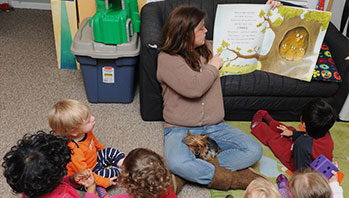- build
- fit
- house
- size
- tool
MA Standards:
English Language Arts/Literature/RL.PK.MA.1 With prompting and support, ask and answer questions about a story or a poem read aloud.
English Language Arts/Literature/RL.PK.MA.4 With prompting and support, ask and answer questions about unfamiliar words in a story or poem read aloud.
English Language Arts/Literature/RL.PK.MA.9 With prompting and support, make connections between a story or poem and one’s own experiences.
Head Start Outcomes:
Literacy Knowledge/Book Appreciation and Knowledge Asks and answers questions and makes comments about print materials.
PreK Learning Guidelines:
English Language Arts/Reading and Literature 6 Listen to a wide variety of age appropriate literature read aloud.
English Language Arts/Reading and Literature 10 Engage actively in read-aloud activities by asking questions, offering ideas, predicting or retelling important parts of a story or informational book.
Read Together: Tell the Truth, B. B. Wolf #2

© Commonwealth of Massachusetts, Department of Early Education and Care (Jennifer Waddell photographer). All rights reserved.
ELA Focus Skills: Active Listening, Distinguish Between Fantasy and Reality, Interpreting Illustrations, Making Connections, Phonological Awareness (Rhythm and Rhyme), Recognize Environmental Print, Vocabulary
Before You Read
Hold up Tell the Truth, B. B. Wolf and ask children to read the title. Say, Who remembers this story? What is it about? Allow children to tell what they remember of the story.
Read the names of the author and illustrator and talk about the cover art. Guide children to understand that people sometimes ask a person to raise his or her hand and say that he or she will tell the truth.
As You Read
As you read, hold the book so children can see the pictures. Talk about the pictures with children. Clarify any unfamiliar vocabulary and talk about any environmental print.
- Read the first line and say, The author says it’s “Fix-up” day. What are the villains, that is, the bad characters who live here, doing to help fix up their community?
- Have children identify the tools they recognize on this page and throughout the reading.
- Pause at the end of the story. Point to the wolf’s building plans and the finished pigs’ house. Talk about how the wolf built three doors for the pigs. Ask, How do you know the wolf built the house for the three little pigs? How do you know he wanted to build the house the right size, or fit, for the pigs?
After You Read
After you finish the story, talk about it with children. Ask, What did Wolf do to show that he was really sorry? Do you think he is really no longer a menace or a danger to others?
